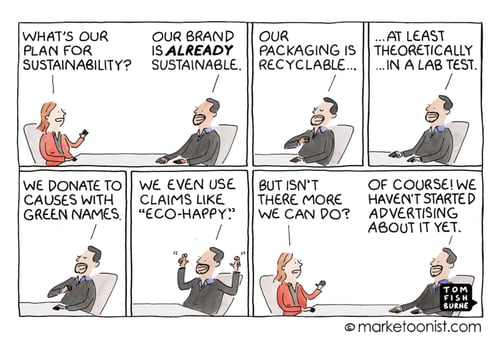
What Is Sustainable Marketing?

The earth is getting hotter and so is the market for sustainable products and services. From recyclable packaging to biobased products, consumers are demanding that companies develop sustainable practices that have a neutral or positive impact on the earth and its inhabitants.
Adidas and Lego are just a couple of the companies that are racing to meet the demands of these savvy, eco-conscious consumers and they’re using sustainable marketing strategies to demonstrate their commitment.
If you’ve been merely dipping your toe in the eco pool, consider this: nearly 80% of respondents in an IBM survey said sustainability is important to them and almost 60% would even go so far as to change their shopping habits to better the environment.
In the end, it’s nearly always the consumers who move the needle through their shopping habits. Whether you manufacture medical devices or food products, you need to think green and create a message that will make your customers take notice.
What Is Sustainable Marketing?
Companies committed to sustainability put the future of the planet and its inhabitants over profit. This might mean investing in biobased materials that are biodegradable or recyclable or using manufacturing processes that produce minimal CO2 emissions, even if the profit margins are lower.
Organizations develop and implement sustainable marketing plans for a variety of reasons, aside from moral ones. For example, they might use this form of marketing as a way to respond to public criticism about the company’s impact on the environment and their commitment to developing more sustainable practices.
Sustainable marketing tells the story of your company’s commitment to sustainability by focusing on your overall brand, the raw materials of your products, how those products are produced, your mission, your vision and more. This all depends on your company’s goals and where you are on the sustainability path.

Why the Sustainability Craze?
The additional CO2 and other greenhouse gases we humans have added as a result of our throw-away, consumer culture is finally catching up to us, resulting in increased inclement weather incidents, unusual temperatures, and rising sea levels that will impact housing, food, health and safety.
Although we’ve come a long way from the “material world” consumerism of the 1980s, single-use plastic is on the rise and is one of the biggest hurdles we have to jump in the sustainability race.
The general public’s increasing awareness of the grim predictions of our planet’s future is inspiring them to take action. In addition to advocacy, consumers are voting with their pocketbooks and are making their voices heard through social media platforms.
Some are even taking matters into their own hands, such as the engineering students at Wichita State. In response to the data that Americans throw away 300 million pairs of shoes annually, they developed a recycling project to keep shoes out of landfills.
Savvy companies are listening to consumer demand for sustainable products and get positive, often free press, as a result. Adidas offers sustainable footwear and received a “good” rating in the area of sustainability from Good On You, one of many websites that offer information and ratings regarding a company’s green efforts.
What’s the Difference Between Sustainable and Green Marketing?
People often use the terms “sustainability,” “green” and “eco-friendly” interchangeably, but many would argue there are subtle differences, which are important to understand when developing your sustainable marketing content.
Sustainability analyses the future impact of today’s actions on the planet, including its resources, inhabitants, climate and economy. Then, it seeks to find practices that can be sustained or continued in the future. The goal is to meet the needs of future generations and not just today’s.
The term “green” is more nebulous. People often use this term to refer to the eco-friendly qualities of products and their production but may or may not look at the long-term impact.
Consumers in all of these areas tend to care about similar issues, including:
- The health and environmental impact of products and their impact on wildlife, air quality, greenhouse gas emissions, global warming and climate change
- Whether the products are biodegradable and/or able to be recycled
- The amount of CO2 emissions and other greenhouse gases released during production
- Issues related to social impact, such as fair wages, the humane treatment of workers and animals, honesty and integrity
Consumers shopping for eco-friendly products and sustainable products are often one and the same and since the terms are often used interchangeably, you should take this into account when focusing on SEO.
Creating a Sustainable Marketing Plan
Whether your company is an ace in the sustainability race or a fledgling just entering the eco world, a sustainable marketing plan is necessary to tell the story of your organization as well as address customer concerns about the environment.
Content strategies might include regular blog posts, social media posts, videos, ads and other content that highlights the sustainability or “green” qualities of the company.
Pro Tip: Develop a sustainable marketing plan to showcase what you’re doing right or to reveal your plan for cleaning up your act. Otherwise, your company will go unnoticed as savvy sustainability shoppers whiz by in their digital search for greener pastures.
Partner With a Sustainable Marketing Expert
Using sustainable marketing strategies to tell the world about what you’re doing and how you’re doing it not only helps your business, but it creates positive peer pressure for others to do the same.
Creating and disseminating this message isn’t easy, and we’ve found that large companies often face the following challenges when creating sustainable marketing content:
- Talking about sustainability in a way that aligns with the company’s sustainability goals
- Responding to negative press in a positive way
- Showing how they’re different than their competitors
- Creating an overarching message of how the company treats people and the planet and in a way that aligns with its brand, mission and vision
Now is the time either to start taking steps on the path of sustainability or to up your ante in the game. Even if you are engaging in sustainable practices, it's not enough to do the right thing. You have to let everyone know about it.
Contact us today to find out how we can help you develop your sustainable marketing plan and content.



